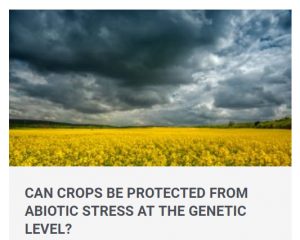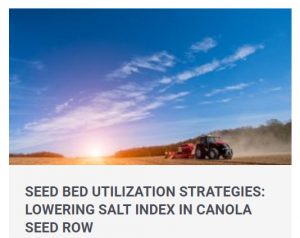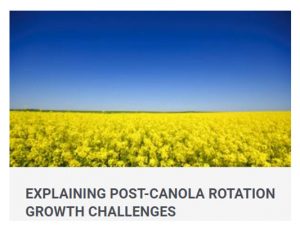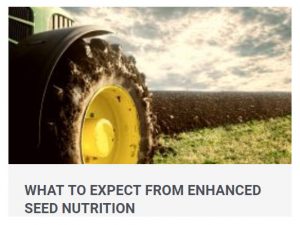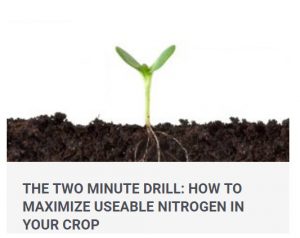THE TAURUS ADVANCED ACRE™ Q&A
Thank you for participating in The Taurus Advanced Acre™ Questions. Answers will be posted after the Ag In Motion Outside Farm Expo is completed July 20th.
Test your knowledge!
Question # 1:
Pollination is a critical phase of a plants life that directly impacts production.
When looking at plants what are the four main contributors to yield? –Active Flower™–
Hint:
- Plants per acre
- Pods/heads per plant
- Seeds per pod/head
- Weight per seed
3 of the 4 are determined at pollination timing or there after. Don’t cut your crop short through this critical phase.
Question # 2:
Fertilizer continues to be one of the highest percentage of input investments growers make on an annual basis.
How confident are you in your fertility program; is there room for improvement or potential savings; how can you know for sure?
–Agronomy & Analytics–
Hint:
A&L’s combination of Soil Health Analysis & Plant Monitoring Program can eliminate any guesswork. Technology available to today’s generation of grower’s allows us to ask the plant what it needs and make our decisions accordingly. Annual fertility report cards open the door to increased production both in this years crop and future crops to come on that acre.
Question # 3:
Young plants can have a rough life with many abiotic stresses that chip away at yield. By keeping your plants healthy all along the way, you are “Building” the framework for an economically successful plant.
If plants are going through one of many abiotic stresses in their early life, and then get hit with herbicides for weed control, what impact can that have on production?
–Active Build™–
ANSWER:
Growers locally and abroad, as well as, internationally are increasingly adopting practices that maintain a “Health” focus on plants through critical stages of their life. Active Build insures the healthiest plants resisting Abiotic stresses with a key nutrient package to “Build” strong healthy plants activated by Intrinsic to insure positive building blocks are put in place for a strong plant factory. Years of third party research measured by yield confirm this to be an economic approach.
Question # 4:
Know Your Limit- It’s a proven fact that the salt index of traditional phosphorus sources cause injury when placed near the seed. This seedling injury reduces stand count and yield.
Is Seed Placed Fertilizer Limiting Your Crops Potential? What happens to the seed when exceeding safe seed placed phosphorus fertilizer rates?
Hint:
ANSWER:
Fertilizer injury can occur by two main mechanisms: ammonia toxicity and salt injury.
Ammonia (NH3) toxicity occurs when urea [(NH2)2CO] is placed with or very near seed.
Salt injury occurs commonly with high applications rates of seed placed phosphorus fertilizer. The salts in the fertilizer cause injury or death of the seedling. Injury occurs when the concentration of fertilizer salt in the seedrow is greater than the concentration of natural salts within the cells of the germinating seed, resulting in higher osmotic pressure in the soil versus the seedling. This causes water to move out of the seedling cells. When water moves out of plant cells, the tissue desiccates, causing injury or death of the seedling. The term “fertilizer burn” comes from the visual appearance of blackened seed and roots.
When seedbed soil moisture conditions are marginal or very poor, fertilizer salts become more concentrated in the soil solution. This results in a higher osmotic pressure, causing a greater potential for injury to germinating seedlings. Fertilizer injury is an increasing concern in drier spring soil moisture conditions immediately after seeding. Also, when soil temperature is cooler, roots grow more slowly, causing roots be exposed to the higher concentration of fertilizer for a longer period of time.
Different fertilizers have different Salt Indexes. Salt index (SI) of a fertilizer is a measure of the salt concentration that fertilizer induces in the soil solution. Salt index is the ratio of the increase in osmotic pressure produced by a fertilizer material. Nitrogen (N), potassium (K) and sulphate-sulphur (SO4-S) fertilizers generally have higher SI values than phosphorus (P) fertilizer.
Phosphate is often limiting in most Prairie soils and often placed with or near the seed for best crop response. The safe rate for cereal crops is about 50 lb/ac of P2O5 for wheat and barley in all Prairie provinces. For canola, the safe seed-placed rates of phosphate at a 10 per cent SBU for Alberta, Saskatchewan and Manitoba are 15, 25 and 20 lb/ac of P2O5, respectively. In Alberta, injury has been observed at rates as low as 15 lb/ac of P2O5, therefore the recommended rate is more cautious compared to those for Saskatchewan and Manitoba. Conversely, recommendations for safe rates of P2O5 with peas are higher in Alberta versus Saskatchewan due to differences in observed field research trials. As a general rule, total pounds of (P2O5) plus total pounds of K2O should not exceed the maximum safe rate of seed-placed phosphate. See more at: https://www.topcropmanager.com/fertility-nutrients/determining-safe-rates-of-seed-placed-fertilizer-16268#sthash.KPKdyK8n.dpuf
Good news is some promising work is being done to find ways to reduce salt index by blending MAP and NEW Plant Activated CRYSTAL GREEN phosphorus which has a significantly lower salt index Blending MAP and Crystal Green phosphorus product opens the door to several possibilities.
Question # 5:
The canola Rotation Inoculant-Make your soil come alive
Growers and researchers have long observed that crops following canola in a rotation tend to demonstrate reduced yield, compared to the results when seeded behind another crop.
Why do canola stubble fields yield lag behind in the next year?
–AGTIV® PULSES/ AGTIV® SOYBEAN–
Hint:
ANSWER:
CANOLA ROOTS, are non-hosts for Mycorrhizae and contain glucosinolates (GSLs) that are potentially hydrolysed in soil to release isothiocyanates (ITCs), which are toxic to arbuscular mycorrhizal fungus. As field experiments have indicated that colonisation is reduced in crops following Canola (brassicas).
Legumes are especially prone to mycorrhizal association. Crops such as canola, are non-mycorrhizal and can severely reduce mycorrhizae populations and delay their development in crops that follow the non-mycorrhizal crops in rotation. Less inoculum then delay the colonization of the roots and reduces the benefits mycorrhizae bring to early season P uptake, and causes impaired phosphate nutrition.
Question # 6:
The greatest yield potential is the day you put the seed in the ground. Every day there after you are just trying to salvage the potential you started with.
How do we insure our seedlings get off to the strongest start?
Hint:
ANSWER:
Life is not always easy for a small or vulnerable seedling. Active Prime insures it has the quick access to important nutrients early, along with a patented technology in Intrinsic that creates a positive impact in early growth of a plant, regardless of the environment the seed is placed into or has to defend against. The success of this strong start is determined by years of third party research in the form of economic yield.
Question # 7:
Environmental and recent economic issues have demanded farmers pay more attention to better understand the role and eventual fate of Nitrogen throughout their farming practices.
Why should I use a Nitrogen Stabilizer?
Hint:
ANSWER:
This answer requires a basic understanding of how nitrogen is lost, which depends entirely on which product you apply.
When surface applying Urea or UAN, it is important to note that these forms of Nitrogen are not “plant available”. A conversion process must take place in order for this Nitrogen to be “plant available”.
Your soil type, soil pH, rainfall, temperature, and incorporation methods play a vital role in determining whether loss will occur during this conversion process. Since these factors are largely dependent on our unpredictable environment, a Nitrogen stabilizer such as ArmU, can provide you peace of mind to ensure your Nitrogen is being stabilized in the soil and not lost to the atmosphere.



